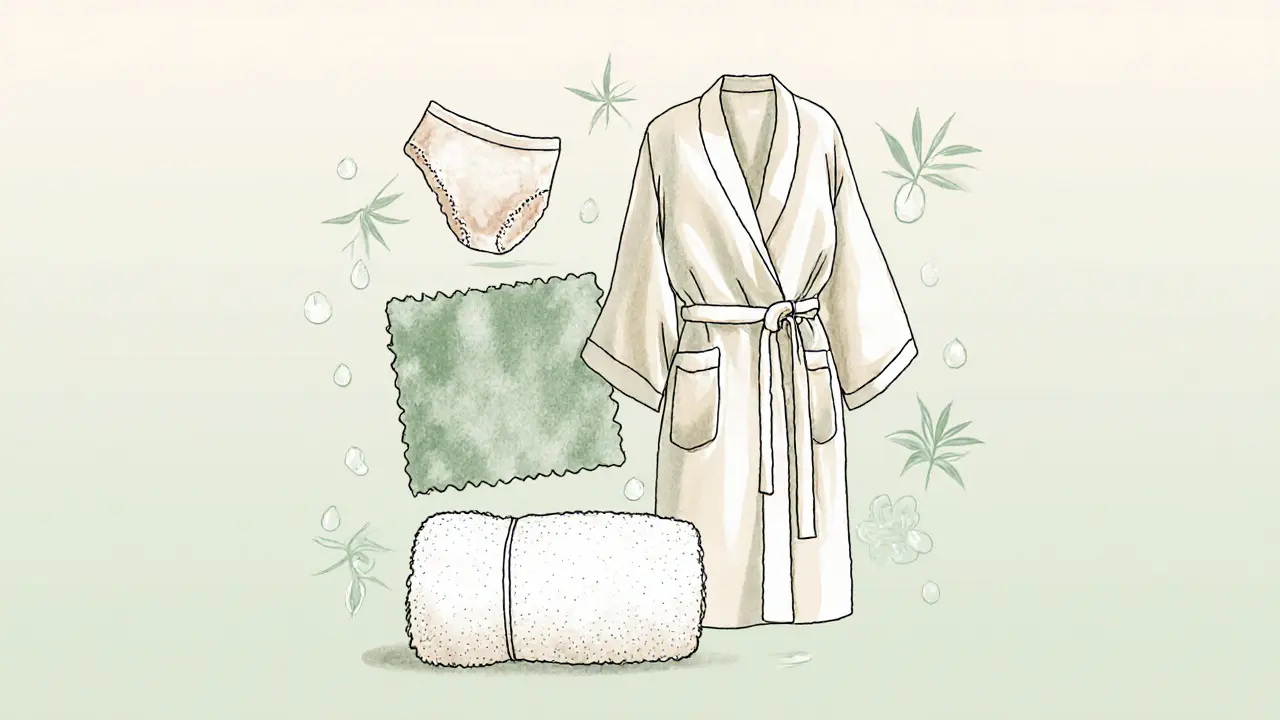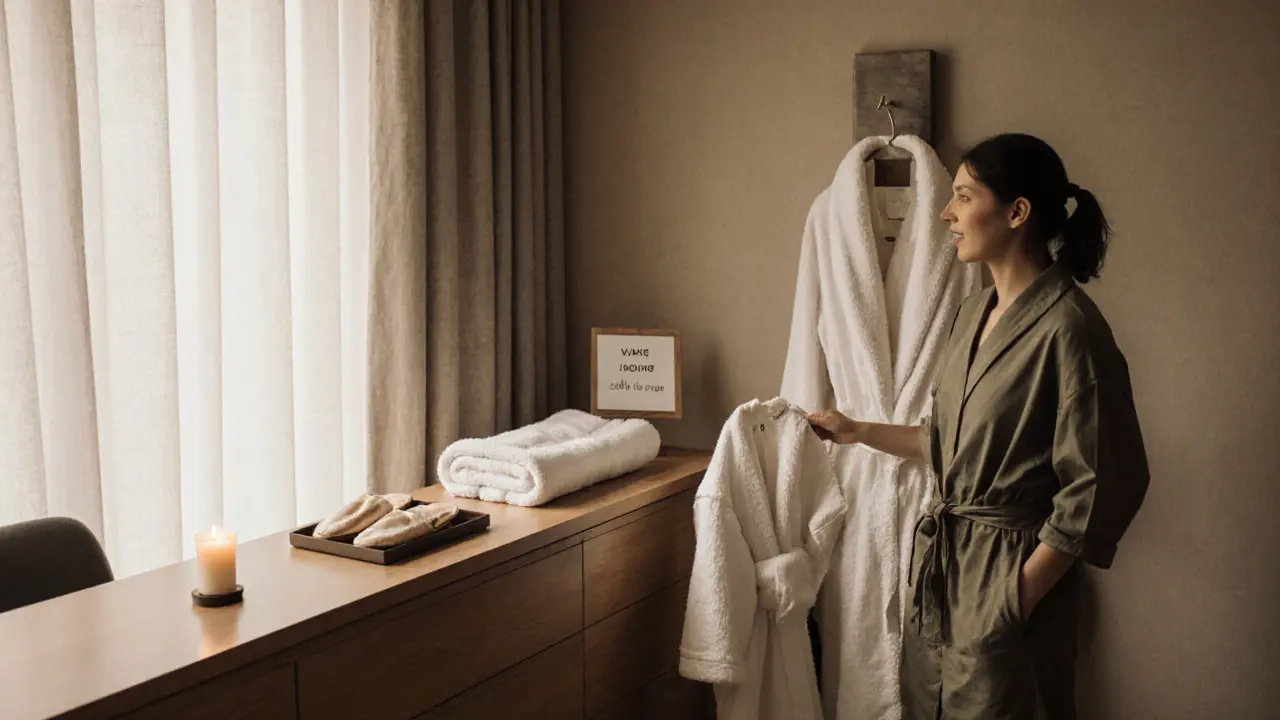Ever walked into a spa and wondered whether you should strip down to nothing, keep your underwear on, or slip into a robe? body massage attire can feel like a puzzling detail, but getting it right makes the whole experience smoother, more relaxing, and respectful for everyone involved.
Quick Takeaways
- Most massages are done fully clothed; you’ll usually keep on underwear or a swimsuit.
- Loose, breathable fabrics (cotton, bamboo, silk) work best.
- A robe or a large towel before and after the session helps with modesty and warmth.
- Always follow the specific spa’s dress code and discuss any preferences with your therapist.
- Hygiene, comfort, and personal comfort levels are the three pillars of the right attire.
Understanding the Basics of Massage Attire
What a Body Massage Actually Is
Body massage is a therapeutic practice that involves manual manipulation of muscles and soft tissues to improve circulation, relieve tension, and promote relaxation. The focus is on the body, not the wardrobe, but what you wear can affect the therapist’s technique and your comfort.
Core Clothing Elements
The typical attire packet includes:
- Underwear - a simple cotton brief, bikini, or sports bra.
- Robe - a plush, easy‑to‑wrap garment for pre‑ and post‑massage.
- Towel - used to cover areas the therapist isn’t working on.
- Massage oil - aids glide; you usually stay clothed while it’s applied.
How It Differs From Other Wellness Practices
Unlike a yoga class where you’re encouraged to wear tight, form‑fitting gear, a massage session values loose layers that can be easily removed or draped. The comparison below highlights the main differences.
| Practice | Typical Clothing | Key Reason |
|---|---|---|
| Body Massage | Underwear + robe + towel | Maintain modesty, ease of draping, hygiene |
| Yoga | Form‑fitting leggings, sports bra | Freedom of movement, alignment feedback |
Who Can Benefit From the Right Attire?
Anyone getting a therapeutic massage - whether you’re a seasoned spa‑goer, a pregnant client, an athlete, or someone trying a first‑time session - will find that sensible clothing improves the outcome. The right fabric also matters for people with skin sensitivities or allergies.
Benefits of Choosing the Right Massage Clothing
Comfort and Relaxation
Soft, breathable fabrics keep your body temperature steady and prevent chafing. When you’re not distracted by an itchy shirt or a tight pair of panties, you can sink deeper into relaxation, which enhances the therapist’s work on muscles.
Maintaining Hygiene
Clean cotton or bamboo underwear provides a barrier between your skin and the massage table. A fresh towel or robe minimizes the spread of oils and sweat, which is especially important in shared spa settings.
Facilitating Therapist Technique
Loose clothing lets the therapist slide hands smoothly over large muscle groups. Tight garments can restrict movement, cause tugging, or even lead to inadvertent skin irritation.
Professionalism and Boundaries
Wearing appropriate attire signals respect for the therapist’s professional space. It also helps set clear boundaries, making the session feel safe for both parties.
Practical Benefits
| Benefit | Description | Impact on Session |
|---|---|---|
| Temperature Regulation | Breathable fabrics prevent overheating. | Allows deeper muscle work without discomfort. |
| Skin Protection | Underwear acts as a barrier. | Reduces risk of irritation from oils. |
| Modesty | Robe or towel covers sensitive areas. | Enhances mental relaxation and focus. |
What to Expect When You Walk Into a Spa
The Setting
Most spas provide a private room with a padded table, soft lighting, and a locker for your belongings. Spa is a dedicated space designed for relaxation, hygiene, and personalized service. You’ll typically be offered a robe and a towel as soon as you arrive.
Typical Process
- Check‑in and fill out a brief health questionnaire.
- Change into the provided robe or your own loose clothing.
- Discuss pressure level, problem areas, and any clothing preferences with the massage therapist.
- The therapist will drape a fresh towel over you, exposing only the area being worked on.
- After the session, you’re given time to dress and re‑hydrate.
Customization Options
Some spas let you wear a swimsuit for hydro‑massage, or a light cotton shirt for a Swedish massage. If you’re pregnant, a maternity‑friendly garment will be offered. Always tell the therapist what feels comfortable.
Communication Is Key
Before the massage begins, state any allergies (e.g., to certain oils), skin conditions, or modesty concerns. The therapist will adjust towel placement, pressure, and even the type of oil accordingly.

How to Prepare Your Own Massage Attire
Setting Up at Home
If you’re arranging a private massage, clear a quiet space, lay down a clean sheet, and keep a soft blanket or robe within reach. A sturdy, low‑height table works best for draping.
Choosing the Right Clothing
Pick items that meet three criteria:
- Fit: Loose enough to slide on and off without pulling.
- Fabric: Natural fibers like cotton, bamboo, or silk for breathability.
- Cleanliness: Fresh, lint‑free garments to avoid contaminating oils.
Step‑by‑Step Guide for First‑Timer Attire
- Take a quick shower; dry skin helps oil absorption.
- Put on a clean cotton underwear or sports bra.
- Wrap a soft robe or large towel around your shoulders.
- Keep a spare towel nearby for the therapist to use.
- Communicate any comfort concerns before the therapist starts.
Tips for Couples or Partner Massages
When giving or receiving a massage with a partner, match the attire: both wear breathable underwear and share a large sheet to maintain modesty. Light scented oils can enhance the mood, but check for sensitivities first.
Safety and Ethical Considerations
Choosing Qualified Practitioners
Look for therapists certified by recognized bodies such as the American Massage Therapy Association or local health authorities. Verify they follow strict hygiene protocols and hold liability insurance.
Safety Practices
| Practice | Purpose | Example |
|---|---|---|
| Clean Linens | Prevent cross‑contamination | Use freshly laundered towels every session |
| Proper Draping | Maintain modesty and warmth | Cover non‑working areas with a large sheet |
| Consent Checks | Ensure comfort levels | Ask before adjusting pressure or exposure |
Setting Boundaries
Both client and therapist should discuss limits ahead of time. If you feel uncomfortable at any point, speak up. A professional will respect your wishes without question.
Contraindications and Risks
People with open wounds, severe skin conditions, recent surgeries, or certain heart conditions should avoid deep tissue massage or seek medical clearance first. Pregnancy requires specially trained therapists.
Enhancing Your Massage Experience
Complementary Practices
Adding a short meditation, breathing exercises, or a warm foot soak before the massage can amplify relaxation. Many spas also offer aromatherapy-choose scents that you know you tolerate well.
Solo vs. Partner Sessions
Solo sessions let you fully focus on personal tension points, while partner sessions can be a bonding activity. In either case, keep the same attire guidelines for consistency.
Helpful Props
Consider a soft neck pillow or a heated blanket if you tend to feel cold. These items don’t interfere with draping but add extra comfort.
Consistency Pays Off
Regular massages-once a month or bi‑weekly-create a routine that your body recognizes. Over time, you’ll know exactly what clothing works best for you, and you’ll see cumulative benefits such as improved flexibility and reduced stress.

Finding Reliable Resources and Professionals
Researching Qualified Experts
Start with online directories that list licensed therapists, read reviews, and verify certifications. Many reputable spas in Dubai showcase therapist bios on their websites.
Online Guides and Communities
Websites like the International Massage Association or wellness forums offer free articles, videos, and Q&A sections about dress codes and best practices.
Legal and Cultural Factors
In the UAE, modesty is culturally important. Most spas require clients to wear underwear under the robe and prohibit overly revealing attire. Respecting local norms ensures a smooth experience.
Further Learning
Books such as "The Massage Therapist's Handbook" and YouTube channels run by certified professionals provide deeper dives into technique and etiquette.
FAQ: Common Questions About Massage Attire
Do I have to be completely naked for a body massage?
No. Most massages are performed fully clothed with a towel or sheet covering everything except the area being worked on. You typically keep underwear on, unless you choose to wear a swimsuit for a water‑based treatment.
Can I wear a regular t‑shirt and jeans?
A loose t‑shirt is fine, but tight jeans can restrict movement and make draping hard. Opt for breathable fabrics and consider swapping jeans for lounge pants or a soft robe.
What if I’m pregnant? What should I wear?
Pregnant clients are usually offered a maternity‑friendly robe and a supportive sports bra. Keep the belly covered with a towel or blanket for warmth and modesty.
Are there any fabrics I should avoid?
Synthetic fabrics that trap heat (like polyester) can make you sweat and feel uncomfortable. Stick with natural fibers-cotton, bamboo, silk, or linen.
Can I bring my own robe or towel?
Yes, many spas allow it as long as the items are clean. A soft, plush robe made of cotton or microfiber works well and ensures you feel at home.
Conclusion: Why Getting Your Massage Attire Right Matters
Choosing the right clothing isn’t just about looking neat-it directly influences comfort, hygiene, and the quality of the therapist’s work. When you arrive in breathable underwear, a cozy robe, and a fresh towel, you set the stage for a session that leaves you relaxed, refreshed, and ready to tackle the day.
A Path to Consistent Wellness
Regular massages paired with thoughtful attire become a simple ritual that supports muscle health, stress reduction, and overall well‑being.
Try It Mindfully
Next time you book a massage, communicate your clothing preferences, wear something comfortable, and enjoy the added sense of calm that comes from being fully prepared.
Share Your Journey
Have you discovered a favorite piece of clothing for massage sessions? Drop a comment below or follow us for more spa‑related tips and tricks.
Some links may be affiliate links, but all recommendations are based on research and quality.


Kiara F
October 15, 2025 AT 18:30Wearing whatever you want without considering basic modesty is just rude.
Nelly Naguib
October 19, 2025 AT 05:50Listen up, the secret to a blissful massage lies in the fabric you drape on yourself! A soft cotton brief or a breezy bamboo shirt lets the therapist glide without fighting against tight seams. Forget those jeans that cinch your thighs – they turn a soothing session into a tug‑of‑war. Choose a robe that feels like a hug, not a prison, and the whole experience upgrades from "meh" to magical. Trust me, the right attire is the hidden catalyst for ultimate relaxation.
Nicole Ilano
October 22, 2025 AT 17:10When you layer up with high‑thread‑count cotton, you minimize friction coefficient between skin and oil, which optimizes the kinetic transfer of shear forces. 🚀 A breathable textile also regulates thermodynamic equilibrium, preventing hyperthermia during deep‑tissue work. Plus, a well‑placed towel acts as a barrier, reducing microbial load and preserving aseptic technique. So, if you want the therapist to focus on myofascial release rather than adjusting your wardrobe, stick to the basics.
Susan Baker
October 26, 2025 AT 03:30From a biomechanical perspective, the selection of massage attire influences not only the client’s subjective comfort but also measurable physiological parameters. The elastic modulus of a garment dictates how much it deforms under compressive loads, thereby affecting the therapist’s ability to apply graded pressure. When fabrics with high moisture‑wicking capacity are employed, evaporative cooling is enhanced, which stabilizes core temperature and mitigates vasodilatory responses that could otherwise lead to orthostatic hypotension post‑session. Moreover, the presence of a seamless underlayer reduces shear stress at the epidermal–dermal junction, diminishing the risk of micro‑abrasions during friction‑based techniques such as Swedish strokes. In contrast, synthetic blends with low breathability trap heat, causing localized hyperthermia that may trigger an inflammatory cascade, counteracting the anti‑inflammatory benefits of the massage itself. The hygroscopic nature of natural fibers like bamboo also interacts favorably with essential oils, preventing dilution and ensuring consistent slip resistance across the treatment field. From a hygienic standpoint, a freshly laundered cotton brief provides a physical barrier that limits the transfer of skin flora, thereby upholding infection control protocols mandated by most licensing boards. Additionally, the draping protocol-where a towel covers non‑treated zones-relies on the underlying clothing to maintain a stable substrate, preventing accidental exposure that could breach professional boundaries. Clinical studies have shown that clients who wear loose‑fitting, breathable attire report higher scores on the Visual Analogue Scale for relaxation, suggesting a psychosomatic link between clothing comfort and perceived therapeutic efficacy. This correlation is further reinforced by neurophysiological data indicating that reduced tactile irritation lowers sympathetic nervous system activity, facilitating parasympathetic dominance. Therefore, the seemingly trivial decision of what to wear is, in reality, a critical component of the treatment algorithm. Practitioners should incorporate attire counseling into the intake questionnaire, explicitly querying material preferences, fit tolerance, and any dermatological sensitivities. By doing so, they not only optimize the mechanical environment for manual therapy but also honor the client’s autonomy and cultural expectations, fostering a holistic sense of safety and trust.
diana c
October 29, 2025 AT 14:50That was a marathon of details, but the crux is simple: pick something that breathes and doesn’t cling. Loose cotton or bamboo does the trick, and it keeps the therapist’s hands moving smoothly. No need to overthink, just aim for comfort and modesty. Your body will thank you, and the session will flow better.